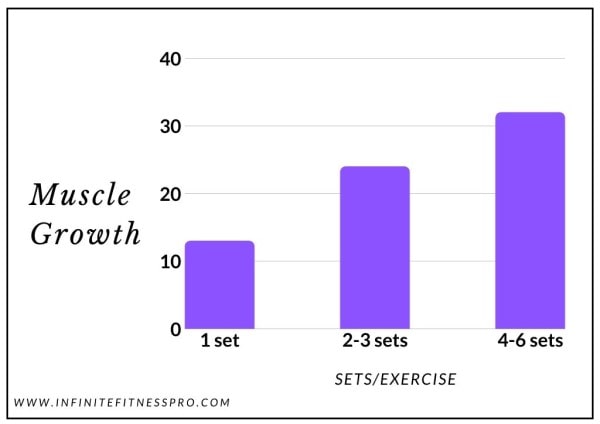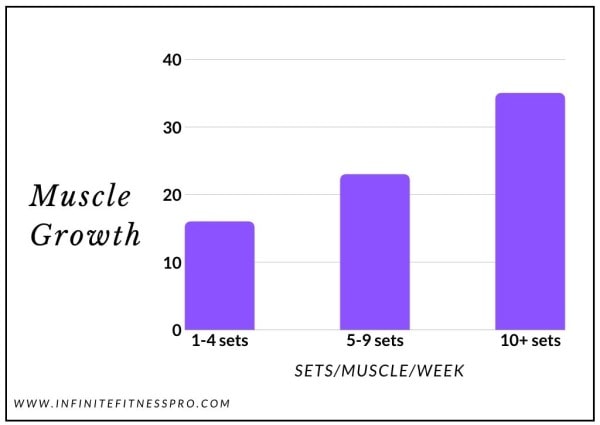If you are confused about how many sets you should do per workout to build maximum muscle mass possible, then you are at the right place.
Some people do a lot of sets and believe in a high volume approach. Whereas, others say that it leads to overtraining and may reduce your gains.
To whom you should listen?
Well, in this article, I’ll clear all your doubts regarding this query based on current scientific evidence.
But first, let’s discuss the terms, volume, sets, and reps.
What are “Volume, Sets, and Reps”?
Reps can be defined as the number of times you are performing a particular exercise without taking rest.
For example, if you are doing dumbbell bicep curls, then in curling the dumbbell up to going down with it, you are completing one rep. Repeating this movement several times continuously without any rest makes it a set.
Now volume is the total amount of weight you lifted during an exercise or the workout. It is the product of the total number of sets, reps per set, and weight in each set.
Volume = sets x reps x weight
In this article whenever I mention a set, it meant to be in the rep range of 6-12. The reason being, it relates to the studies I have mentioned and it is also the hypertrophy rep range to build muscle.
If your main goal is to build muscle mass, you should do most of your sets in this rep range only.
Now let’s discuss what studies say about the number of sets you should be doing.
How Many Sets Per Exercise Should You Do?
In a meta-analysis done to compare the muscle hypertrophy response of single vs multiple sets per exercise shows that:
As the number of sets per exercise increases, the amount of the muscle you gain also increases.
2-3 sets per exercise lead to a much greater increment in muscle size than a single set. And 4-6 sets are further better than 2-3 sets.

How Many Sets Per Muscle Should You Do?
In 2017, a study was done to check the relationship between resistance training volume and an increase in muscle mass. That study was done on 34 groups in three different categories ( less than 5, 5-9, more than 10 sets).
Results show a significantly positive impact of increasing the number of sets per muscle per week on muscle growth.
The best hypertrophy results were shown in doing more than 10 sets per muscle per week.

So now it is clear that by doing more sets and high volume, you can significantly increase your muscle size.
Is There Any Upper Limit For Sets Per Workout?
No doubt that adding a number of sets can increase muscle hypertrophy but everything has its own limits.
Beyond that limit, you can overtrain your muscles and may get negative results.
A 2017 meta-analysis shows that roughly 10-20 hard sets per muscle group per week is the optimal range for maximum muscle growth.
Now it depends on your muscle mass and experience level that how many sets you should do.
Advanced lifters need a higher number of sets to annihilate their muscles. But if you are a beginner then start with 10 sets per muscle and then keep on increasing as you progress.
How To Incorporate This In Your Workout Routine
You must have heard the quote – “Don’t train just hard, train smart“.
A smart set-up training program can cause a significant impact on your muscle-building goals.
Let me explain it by giving an example. Let’s say you are an intermediate lifter and you need 16 sets per muscle per week.
Rather than following bro-split and doing all the 16 sets in a single workout, it would be better to train more than one muscle group in a workout.
For example:
| Mon Tues Wed Thur Fri Sat | Legs and Shoulders Chest and Back Biceps, Triceps, and Forearms Legs and Shoulders Chest and Back Biceps, Triceps, and Forearms |
Do 8 sets for each muscle group per workout session.
You can also perform a push/pull/legs split or an upper/lower split.
Why should you train like this?
Split training provides you several benefits over the typical bro-split:
- You can do a lot of sets without crossing that 10 sets per muscle per workout limit.
- You’ll be able to train each muscle 2x/week.
- No risk of overtraining.
- Better muscle recovery as you are not giving a very high volume in one go.
This leads to better muscle gains and recovery.
What researches say about this?
A 2019 study was tested a similar example I have just given. The purpose of this study was to check the effects of resistance training frequency on muscle gain and neuromuscular performance.
They divided the participants into two groups. In one group, people train each muscle once in a week with 16 sets whereas another group did split training and train each muscle 2x/week with 8 sets per muscle per session.
After a period of 8 weeks, the 8 sets per muscle per workout group reported slightly better muscle growth. However, there was no major difference in strength gain of both the groups.
Hence, training each muscle twice a week with 6-10 sets per muscle per workout is optimal for muscle gain. It increases muscle hypertrophy in the long run and also refrains you from doing a very high volume for a muscle group in the same session.
How Many Sets Per Workout – The Takeaway
Here are the key points of the article you should take home.
- How many sets per muscle per workout should you do? Well, there are several scientific studies that prove about 10-20 sets per muscle group per week gives you better muscle-building benefits.
- However, the exact number depends on various factors like:
- Your training experience,
- The muscle mass you have,
- Your fitness goal,
- The exercises you choose, etc.
- Rather than doing bro-split and giving a huge volume to a muscle group in a single session, go for a split workout:
- Push/Pull/Legs,
- Upper/Lower split, or
- Simply train 2 muscle groups daily.
- Do 8-10 sets/muscle/workout and train each muscle 2x/week. This strategy is good for muscle recovery and gives you better hypertrophy results.
In the end, you have to listen to your body. Some people get good results in less volume while others require a lot more sets and high volume.
Take these science-based points as a reference and change the number of sets and workout volume as your body responds.
Thank you for reading this far. I hope you enjoyed and learned something from this article. For any query, feel free to leave a comment.




